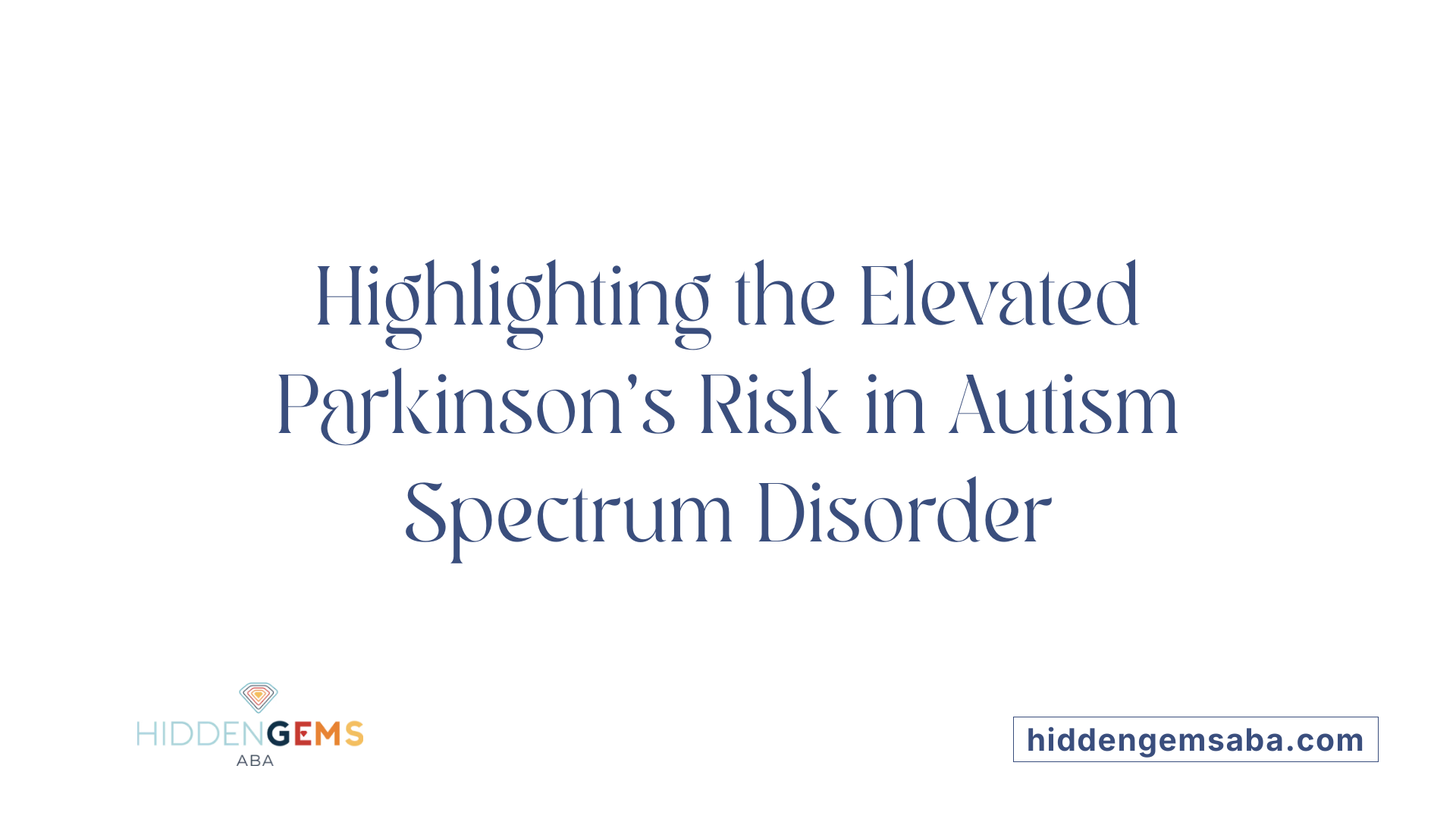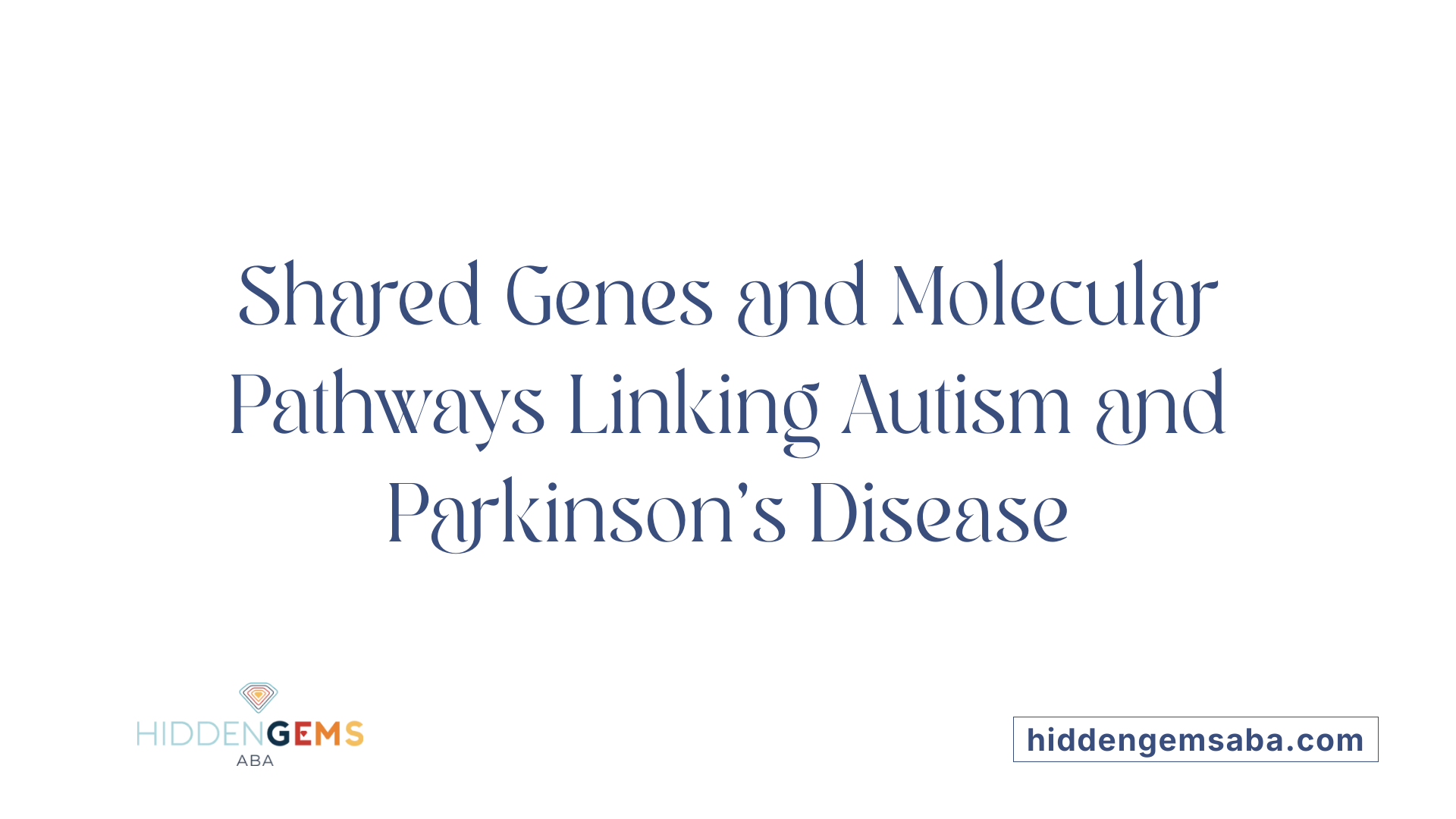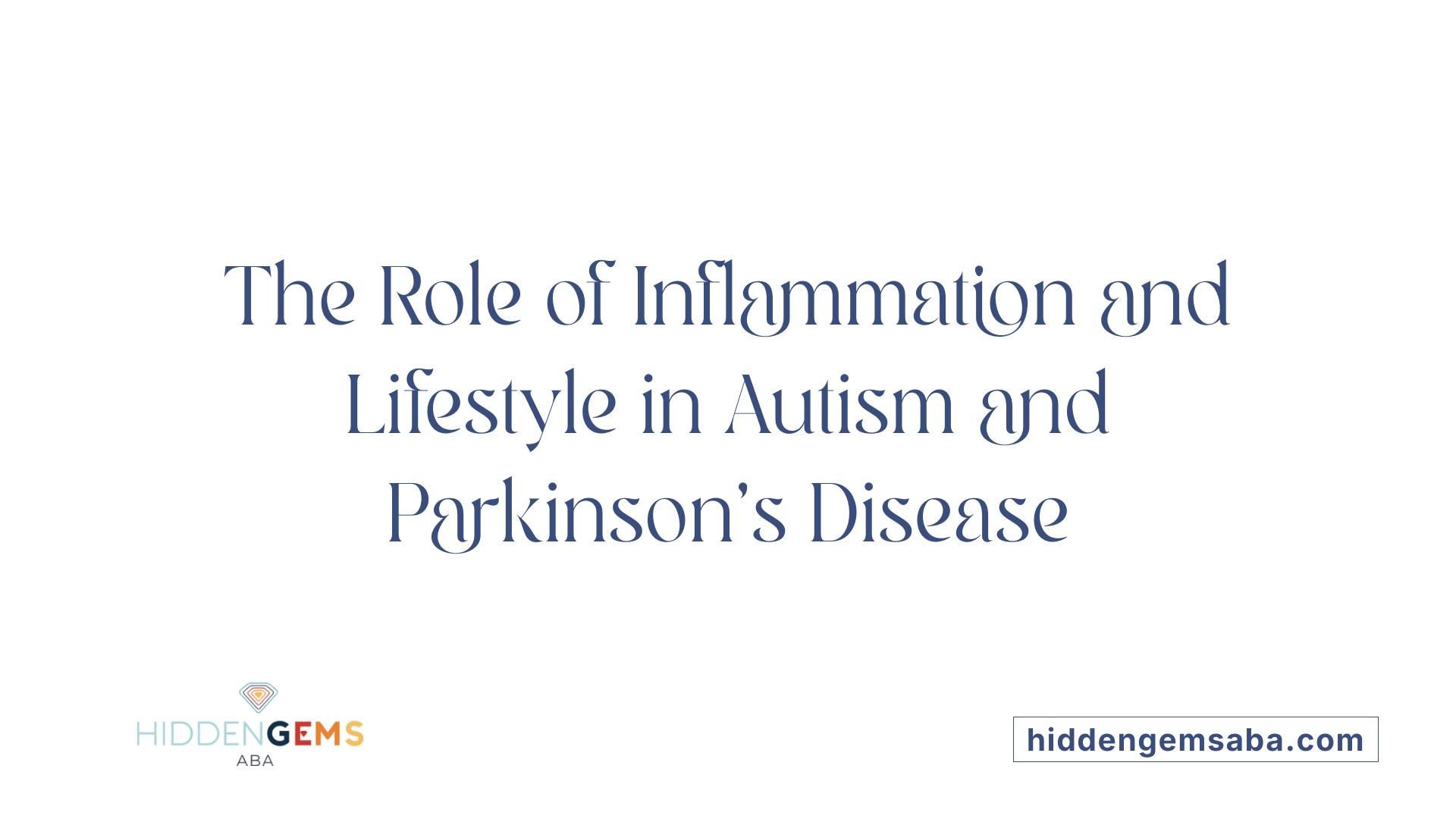Unveiling Common Ground in Neurodevelopmental and Neurodegenerative Disorders
Recent scientific research reveals compelling evidence of shared biological pathways, genetic factors, and pathological mechanisms linking autism spectrum disorder (ASD) and Parkinson's disease (PD). Understanding these connections enhances our knowledge of brain health, informing treatment strategies and prompting new avenues for research. This article delves into the intricate relationship between ASD and PD, exploring their biological intersections, genetic overlaps, and the impact of lifestyle factors like inflammation on disease development, with implications for clinical management and future therapies.
Epidemiological Evidence of Increased Parkinson's Risk in Autism

What is the scientific and clinical relationship between autism spectrum disorder and Parkinson's disease?
Recent research highlights a notable connection between autism spectrum disorder (ASD) and Parkinson's disease (PD). Studies reveal that individuals with ASD are at a substantially higher risk of developing PD, especially early-onset variants. Epidemiological data indicate that children and adults with ASD are more likely to exhibit Parkinsonian features such as tremors, rigidity, and gait freezing.
One prominent study from Sweden analyzed over 2.2 million individuals born between 1974 and 1999. It found that autistic people had more than four times the risk (relative risk of 4.43) of developing PD compared to non-autistic individuals. Interestingly, the cases of Parkinson's identified in this population focused on early-onset PD, predominantly diagnosed before age 50, emphasizing a possible overlap in neurodevelopmental and neurodegenerative mechanisms.
Genetic investigations reinforce this link, with mutations or variations in genes like PARK2, RIT2, and CD157/BST1 implicated in both ASD and PD. These genes influence critical processes such as mitochondrial function, synaptic integrity, and dopamine regulation, which are central to both disorders.
Furthermore, neuroinflammation and mitochondrial dysfunction, common features in both conditions, suggest shared pathogenic pathways impacting neuronal health. Structural brain changes observed in autism also mirror those seen in PD, such as dopaminergic neuron deficits.
In summary, accumulating evidence points to a robust biological and clinical relationship between ASD and PD. This connection underscores the importance of ongoing research into shared mechanisms to develop targeted interventions and support for aging individuals with autism.
Genetic and Molecular Overlaps Between Autism and Parkinson's Disease
 Shared susceptibility genes have been identified that link autism spectrum disorder (ASD) and Parkinson's disease (PD). Research indicates that both conditions involve genetic variations affecting neuronal pathways, especially those involving dopamine and mitochondrial function. Notably, mutations in genes such as PARK2, RIT2, and CD157/BST1 are observed in cases of both disorders.
Shared susceptibility genes have been identified that link autism spectrum disorder (ASD) and Parkinson's disease (PD). Research indicates that both conditions involve genetic variations affecting neuronal pathways, especially those involving dopamine and mitochondrial function. Notably, mutations in genes such as PARK2, RIT2, and CD157/BST1 are observed in cases of both disorders.
Mutations impacting neuronal health and mitochondrial integrity play a significant role in the overlapping pathology. For example, PARK2, which encodes the protein Parkin, is crucial for mitophagy—the process of clearing damaged mitochondria. Dysfunctional PARK2 can lead to mitochondrial damage, neuronal loss in Parkinson’s and has been linked to neurodevelopmental variations seen in some ASD cases.
Similarly, mutations in the PINK1 and DJ-1 genes, important for mitochondrial quality control, are associated with neurodegeneration in PD and may also be involved in ASD pathophysiology. Genes affecting synaptic function, such as SHANK3, which is often mutated in ASD, are also implicated in PD through their role in synaptic plasticity and neuronal communication.
Genetic association studies strengthen the evidence for shared roots. Variants in the RIT2 gene, a regulator of dopamine neuron activity, have been linked to both ASD and PD. Additionally, genes like CD157/BST1 influence immune response modulation and neuroinflammation, which are common features in both conditions.
The convergence of these genetic factors suggests that certain molecular pathways—especially those involving dopaminergic neurons, mitochondrial health, and synaptic integrity—may underlie both ASD and PD. This overlap points to a complex network where disruptions can manifest as neurodevelopmental or neurodegenerative disorders depending on the context and timing of the genetic influences.
Pathophysiological and Neurobiological Commonalities

What genetic, neurological, and pathophysiological factors may link autism and Parkinson's disease?
Research suggests that autism spectrum disorder (ASD) and Parkinson's disease (PD) share several underlying biological mechanisms. At the genetic level, mutations in genes such as PARK2, RIT2, and CD157/BST1 are involved in both conditions. For instance, PARK2, which encodes the protein Parkin, is crucial for mitochondrial quality control through a process called mitophagy. Mutations here lead to damaged mitochondria and neuronal death, which are features of PD and have been observed in some cases of ASD.
Neurologically, both ASD and PD involve the dopaminergic system, which controls movement, reward, and social behavior. In ASD, evidence points to reduced dopamine activity and neuroinflammation, contributing to behavioral symptoms. PD is characterized by the progressive loss of dopamine-producing neurons in the substantia nigra, leading to classic motor issues like tremors and rigidity.
On a broader scale, both disorders show signs of neuroinflammation, which exacerbates neuronal damage and impairs brain function. Chronic inflammation in the brain is increasingly recognized as a root cause of numerous neurodegenerative and neurodevelopmental disorders.
Shared pathophysiological features include mitochondrial dysfunction — where impaired energy production hampers neuron survival — and synaptic impairments that disrupt communication between neurons. These mechanisms can result in the movement difficulties seen in PD and the behavioral and social challenges characteristic of ASD.
Understanding these overlaps highlights the importance of examining both genetic predispositions and inflammatory processes. It also opens avenues for treatments targeting inflammation, mitochondrial health, and dopaminergic signaling to potentially benefit individuals affected by both conditions.
| Factor | Role in ASD | Role in PD | Shared Implication |
|---|---|---|---|
| Dopaminergic dysregulation | Reduced dopamine activity affects social behavior | Dopamine neuron loss leads to motor symptoms | Disruption in dopamine pathways affects movement and social functions |
| Mitochondrial dysfunction | Some genetic mutations impair mitochondrial function | Mitochondrial damage causes neurodegeneration | Mitochondria are essential for neuron energy and survival |
| Neuroinflammation | Increased inflammatory markers associated with behavioral severity | Chronic brain inflammation contributes to neuron death | Inflammation worsens disease progression in both |
By exploring these interconnected factors, researchers can better understand the neurobiological links between ASD and PD, which could guide future therapeutic strategies.
Inflammation, Lifestyle Factors, and Shared Disease Pathways

How do inflammation and lifestyle factors contribute to both autism and Parkinson's disease?
Neuroinflammation plays a central role in both ASD and Parkinson's disease. In these conditions, activated microglia—the brain's immune cells—release pro-inflammatory cytokines, leading to heightened inflammation in the nervous system.
This inflammatory state affects neuronal health, disrupting processes such as synaptic functioning and mitochondrial activity. Persistent inflammation can cause tissue damage, impair normal brain development in children, and contribute to the degeneration of dopamine-producing neurons in adults.
Lifestyle choices significantly influence inflammation levels. Diets rich in anti-inflammatory foods like Omega-3 fatty acids, green leafy vegetables, and wholesome plant oils have been shown to help lower systemic and brain inflammation. Conversely, diets high in processed foods, sugars, and trans fats can amplify inflammatory responses, increasing the risk or severity of neurodevelopmental and neurodegenerative disorders.
Environmental exposures also impact inflammation. Prenatal infections, toxins, and pollutants can trigger immune responses that affect fetal brain development and may predispose individuals to ASD or early-onset Parkinson's.
Managing inflammation through lifestyle interventions—such as dietary improvements, regular exercise, and minimizing toxin exposure—may reduce the severity of symptoms or delay disease progression. The use of specialized diets like the GAPS diet, which supports immune system healing, has also been associated with symptom improvement in some individuals.
Overall, controlling inflammation might serve as a preventive strategy and therapeutic avenue for those affected by autism and Parkinson’s disease, emphasizing the importance of a healthy lifestyle and environmental awareness.
Implications for Diagnosis, Treatment, and Future Research
Monitoring motor and neurodegenerative symptoms in ASD
Autistic individuals are at an increased risk of developing Parkinson's disease (PD), often at a younger age. Studies show that nearly 0.05% of adults with ASD develop PD before age 50. Because of this, clinicians should regularly monitor for motor symptoms such as tremors, rigidity, gait freezing, and decreased facial expression, which are characteristic of parkinsonian features.
Early detection of these symptoms can facilitate timely interventions. It also helps differentiate between typical ASD-related behaviors and emerging neurodegenerative signs, guiding treatment adjustments to improve quality of life.
Shared biological pathways as therapeutic targets
Research indicates that both ASD and PD involve common genetic and biological pathways, particularly in dopamine regulation and mitochondrial function. Variants in genes like PARK2, RIT2, and SHANK3 influence synaptic and mitochondrial health, suggesting overlapping mechanisms.
Targeting these pathways could lead to novel therapies that address core issues in both conditions. For example, therapies aimed at reducing neuroinflammation or restoring dopaminergic balance may benefit autistic individuals at risk of early-onset Parkinson’s.
Personalized treatment approaches
Given the complex interplay of genetics, inflammation, and brain chemistry, personalized treatment plans are essential. Approaches might include:
- Genetic testing to identify susceptibility variants
- Anti-inflammatory diets rich in Omega-3 fatty acids and antioxidants
- Medications to support mitochondrial function
- Early behavioral and motor interventions
Such strategies can be tailored based on individual risk profiles, improving outcomes and potentially delaying or preventing the onset of Parkinsonian symptoms in autistic adults.
| Topics | Focus Areas | Example Interventions |
|---|---|---|
| Monitoring symptoms | Motor signs, neurodegeneration | Regular neurological assessments, early screening |
| Shared pathways | Dopaminergic and mitochondrial dysfunction | Targeted pharmacology, gene therapy research |
| Personalized medicine | Genetic, dietary, behavioral | Customized diets, genetic counseling, early behavioral support |
A Call for Integrative Research and Therapeutic Innovation
The emerging evidence linking autism spectrum disorder and Parkinson's disease underscores the importance of an integrative approach to understanding, diagnosing, and treating these complex conditions. Recognizing shared genetic vulnerabilities, neurobiological pathways, and the role of inflammation opens new horizons for targeted therapies aimed at modulating specific molecular processes. Early detection and intervention in at-risk populations, along with lifestyle modifications that reduce inflammation, may improve quality of life and neuroprotective outcomes. Continued research exploring the intertwined mechanisms of neurodevelopment and neurodegeneration has the potential to revolutionize our approach to brain health, ultimately bridging the gap between neurodevelopmental and neurodegenerative disorders.
References
- Linking autism spectrum disorders and parkinsonism
- Risk of Parkinson Disease in Individuals With Autism ...
- Daily briefing: Autism triples risk of Parkinson's-like symptoms
- Large-scale study links autism to increased risk ...
- Autism linked to elevated risk of Parkinson's disease - News
- Large study links autism to Parkinson's disease
- Risk of Parkinson Disease in Individuals With Autism ...
- Exploring the common genes involved in autism spectrum ...






